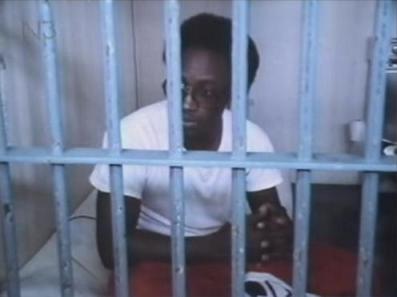On this date in 1987, murmuring “I guess nobody is going to call,”* Edward Earl Johnson was gassed for capital murder in Mississippi’s Parchman Farm prison.

Johnson was convicted of raping a white woman and killing the policeman who answered her distress call. These are no-nos for a young person of color in the South.
Johnson fought his execution for eight years on death row, insisting on his innocence even on his last walk to the gas chamber.
And the case against him looks pretty thin — supported, as these things so often are, mostly by a highly suspect confession Johnson miraculously coughed up when he was out on a drive with John Law. (This led the victim, who knew Johnson and had excluded him as the attacker, to decide he did it after all.)
Needless to say, Johnson’s state-appointed public defender was unable to make the most of these gaping lacunae in the state’s case.
Years later, the prison warden Don Cabana — who was on this date overseeing his very first execution, and was deeply shaken by it — recalled his charge’s fearful situation in testimony to the Minnesota legislature:
He insisted to the very end, somewhat oddly, that he did not commit the crime … my experience with condemned prisoners was always that once strapped to the chair, they came around somehow with something, if only something simple as “Tell the victim’s family I’m sorry,” “Tell my mother I’m sorry,” something that indicated something bad had happened, I was there and I was part of it.
But not so with this young man. When I performed my ritualistic function of asking if he had a final public statement, this young man looked me in the eye with tears streaming down his cheeks, and he said: “Warden, you’re about to become a murderer. I did not kill that policeman, and dear God, I can’t make anyone believe me.”
This is a musty old case by now, but with the growing awareness of false confessions as a contributing factor in wrongful convictions, it may soon come in for a long-overdue re-examination.
Johnson, unfortunately, does not have any prospect of an a-ha forensic science win. However, as with Cameron Todd Willingham‘s case, there’s simply no balance of evidence that should point a fair-minded present-day observer to a conviction beyond reasonable doubt, and a good deal that points to an affirmative conclusion of innocence.
As the (admittedly partisan) Wrongful Conviction: International Perspectives on Miscarriages of Justice sums up,
[t]he murder weapon was never connected to Johnson; indeed, no physical evidence linked Johnson to the crime. The case against Johnson is weakened by his claim of inadequate counsel, his immediate recantation of his confession, and his claim that his confession was produced under threat of death. Also, after Johnson’s execution, a young woman came forward claiming to have been with Johnson on the night of the murder, and claiming also that she had come forward during the investigation but was rebuffed by police.
Edward Earl Johnson is the subject of the riveting BBC documentary Fourteen Days in May.
* Quoted in the New York Times, May 21, 1987.
On this day..
- 1527: Hans Hergot, immovable type - 2020
- 1952: Jan Bula, Czechoslovakian priest - 2019
- Feast Day of St. Baudilus - 2018
- 1622: Sultan Osman II - 2017
- 1691: Mark Baggot, Jacobite spy - 2016
- 1799: Simon Taylor, for indulging in drunkenness - 2015
- 1795: Ignac Martinovics and the Magyar Jacobins - 2014
- 2001: An adult actress stoned to death in Evin prison - 2013
- 1881: Po'olua, "darkened in my mind" - 2012
- 1943: Wilhelm H., pensioner and vandal - 2011
- 2001: Zhang Jun and his gang - 2009
- 1820: Karl Ludwig Sand, a curious strand of German history - 2008

 Jackson was described as standing erect and playing the part of an actor. Walling trembled with his eyes downcast. At that point, Jackson was again asked if he had anything to say. An eyewitness said, “Jackson hesitated fully two moments before he replied. Before he spoke, Walling turned expectantly evidently believing Jackson would speak the words that would save his life, even while he stood on the brink of death. Walling had half turned around and he stood in that position with an appealing expression on his face, while Jackson without looking at him, upturned his eyes and replied, ‘I have only this to say, that I am not guilty of the crime for which I am now compelled to pay the penalty of my life.”
Jackson was described as standing erect and playing the part of an actor. Walling trembled with his eyes downcast. At that point, Jackson was again asked if he had anything to say. An eyewitness said, “Jackson hesitated fully two moments before he replied. Before he spoke, Walling turned expectantly evidently believing Jackson would speak the words that would save his life, even while he stood on the brink of death. Walling had half turned around and he stood in that position with an appealing expression on his face, while Jackson without looking at him, upturned his eyes and replied, ‘I have only this to say, that I am not guilty of the crime for which I am now compelled to pay the penalty of my life.”

